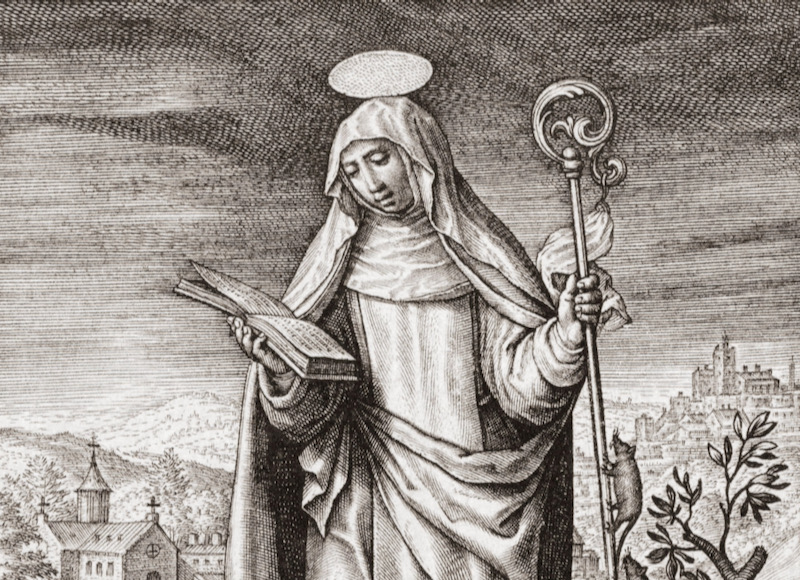It’s 17 March tomorrow, so the subject for this column is St Gertrude of Nivelles whose feast it is. I’ll readily admit that this seventh-century abbess who lived and died in what’s now Belgium may not seem an obvious choice, given that she shares her holy day with the more famous and popular St Patrick. But read on. You’ll find that the saints have more than a feast day in common, their Venn diagrams intersecting in other intriguing ways, and that aspects of Gertrude’s legend provide a partial answer to the question Kate Keefe posited in a Tablet blog last week, “What are saints for?”
Born in around 626, Gertrude was the daughter of powerful and pious Frankish nobles. Called Pepin and Itta, their connections extended to the very heart of the ruling Merovingian dynasty, also encompassing the Christian missionaries then engaged in the conversion of the Low Countries.
A “Life” of Gertrude – a hagiographical or holy biography – written in the eleventh century makes explicit that the future saint was marked out for the religious life from an early age. Aged just ten, Gertrude angrily and courageously resisted a warlord’s suggestion that she should marry his son. The reason wasn’t her tender years (it was common for children to be betrothed in the Middle Ages, marriage and consummation delayed until their teens) but rather her determination to have “no earthly spouse”, as she had already pledged herself to Christ.
Gertrude continued to be assailed by “violators of souls”, Frankish warriors eager to gain her wealthy, well-connected hand in marriage. The death of her father in 650 entailed the very real risk of her forcible abduction by any number of avaricious, power-hungry suitors. Mindful of this peril, Itta ordered her daughter’s luscious locks – simultaneously a mark of her virginity and aristocratic Frankish birth – to be shorn, the crown of Gertrude’s head shaved with the monastic tonsure. Visibly dedicated to the monastic life, Gertrude became a nun at Nivelles, an abbey with both nuns and monks, which her mother had recently founded. These “double houses” were a characteristic of seventh-century monasticism and were invariably ruled by a highborn abbess – in this case the widowed Itta herself. The abbey founded by St Hilda at Whitby at exactly the same time is the best-known English example.
Itta died in 652. Gertrude, possibly in conjunction with St Armand, bishop of Maastricht, assumed governance of the monastery. Nivelles became an important centre for the evangelisation of the Franks, with Gertrude gaining renown for her scholarship, charity and kindness.
The connections of the formidable abbess extended across Christian Europe. Relics and holy books were acquired from Rome. She also nurtured close relations with the Irish monks who were then playing a crucial role in the conversion of the modern-day Low Countries, France and Germany (I promised you an Irish connection, didn’t I? Keep on reading, there’s more to come). Among their number were the future saints Foillan and Ultan who visited Nivelles while making the pilgrimage to Rome. Foillan went on to found a monastery at Fosses-la-Ville, not far from Nivelles, on land given by Gertrude.
Such was Gertrude’s holiness that miracles were attributed to her while she was still alive. Worn out by her austerities, which included wearing a hair shirt, she stood down as abbess aged just 30. Gertrude devoted the final years of her life to study and prayer. A true imitator of Christ, she died aged 33 – His age at the Crucifixion – on 17 March 659. According to her medieval biographer, a pilgrim – usually identified as either Foillan or Ultan – had foretold Gertrude’s death, promising she would “pass joyously” from this world on 17 March, “because blessed Bishop Patrick and his chosen angels…are prepared to receive her”.
The sweet odour emanating from Gertrude’s corpse was a sure sign of sanctity, her body buried at Nivelles clad in a hair shirt and also a veil left at the monastery by a pilgrim. The saint’s veneration spread rapidly; her 17 March feast day was celebrated in England by the time of Bede (d 735). In the last quarter of the thirteenth century, a magnificent precious metal shrine was made to house her relics. This survived intact until World War Two, when in 1940, a German bomb shattered it into pieces necessitating its painstaking reconstruction.
By the fifteenth century, St Gertrude was frequently depicted with rats and mice. This association with vermin survived into modern times. Well into the nineteenth century, supplicants were making votive offerings of small silver mice to her shrine at Cologne Cathedral. Folklorists attempted – unconvincingly – to connect this to pre-Christian religious beliefs. The real explanation is probably much more prosaic and speaks of an experience with which so many of us can identify. As I know all too well, rodents become much more visible and troublesome around the time of St Gertrude’s mid-March feast day.
Which brings me to my response to Kate Keefe’s question: “What are saints for?” Well, I’ll bet very few of us (at least here in Britain and Ireland) have never had occasion to call upon St Patrick’s (or for that matter, St Hilda’s) legendary power over snakes and serpents. I’m equally sure that I’m far from alone in waging a seemingly never-ending battle with mice. Their current determination to avoid my carefully located bated traps and poison blocks means that I’m more than a little tempted to emulate our medieval forebears and seek the friendship, support and miraculous intervention of St Gertrude.



 Loading ...
Loading ...
What do you think?
You can post as a subscriber user ...
User comments (0)